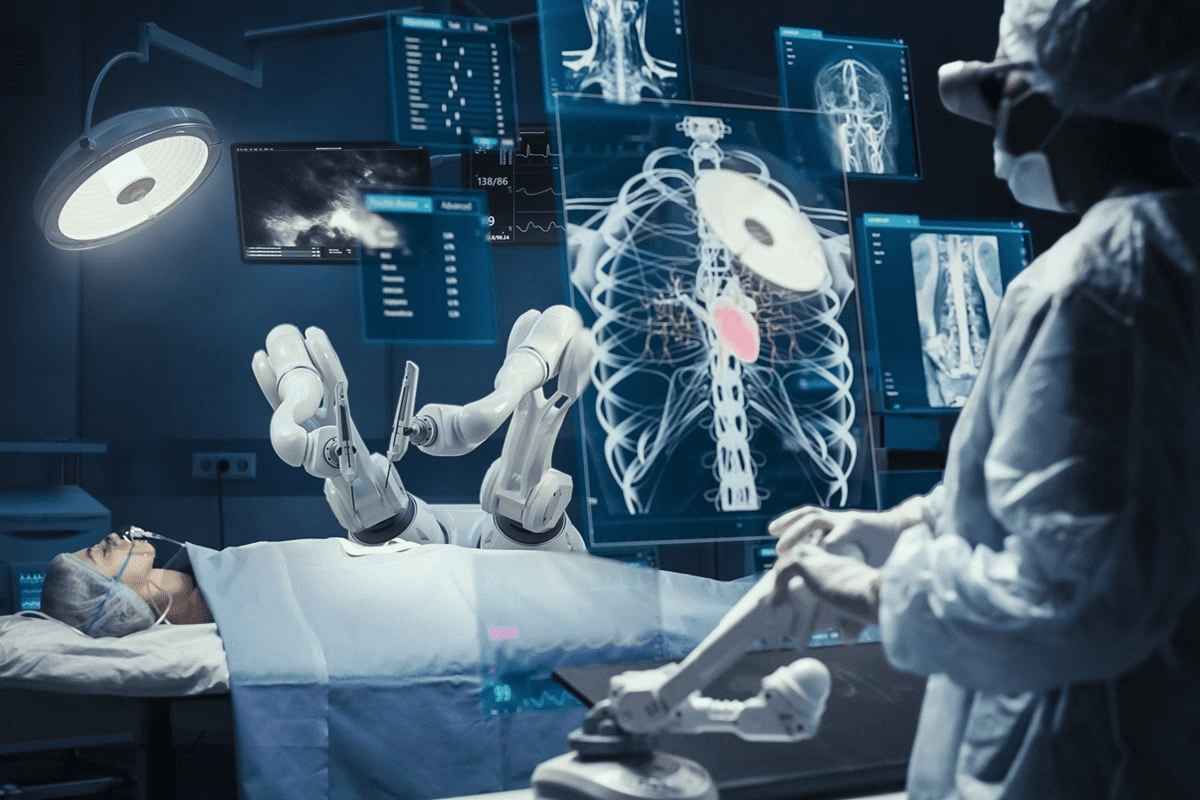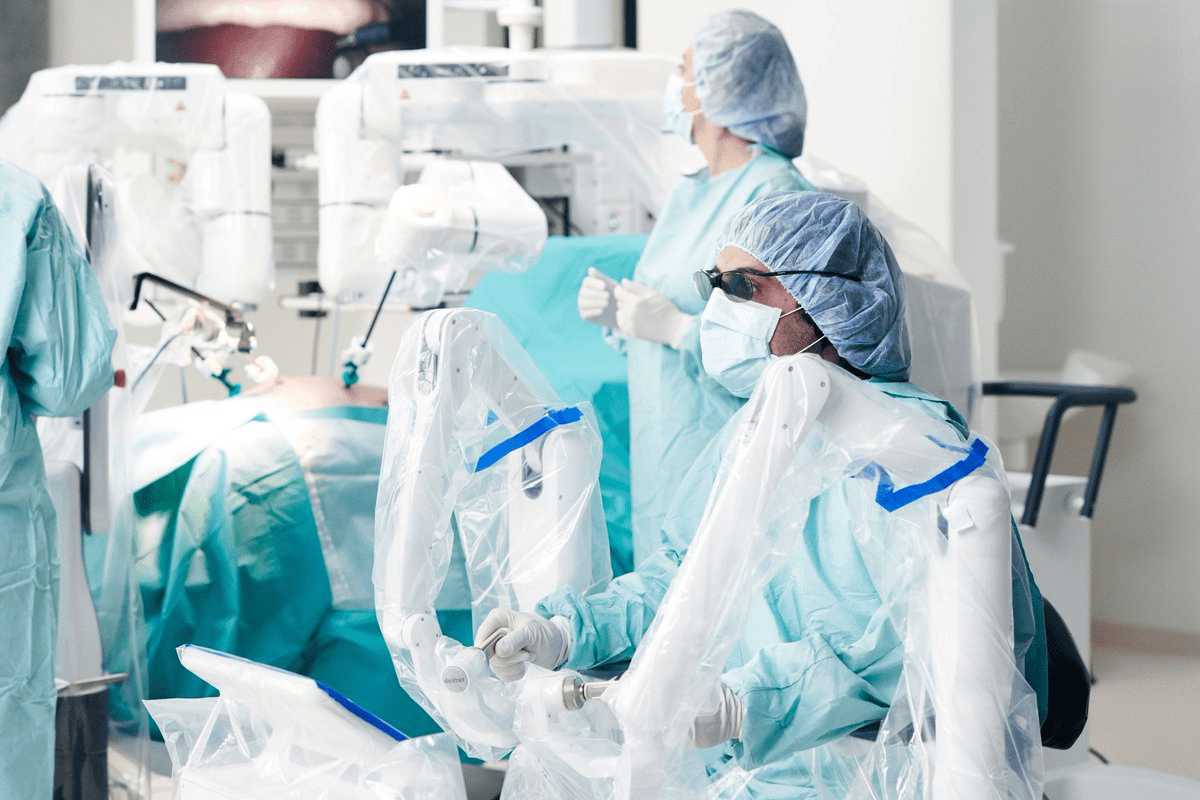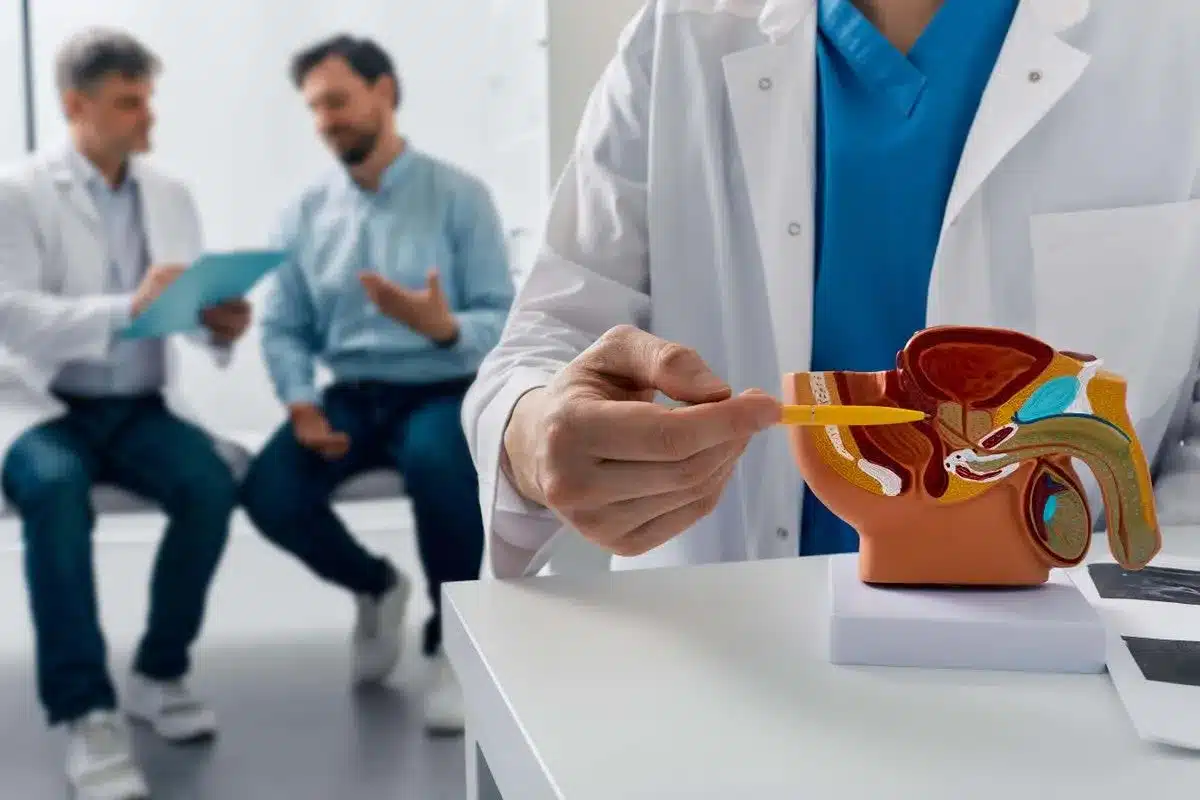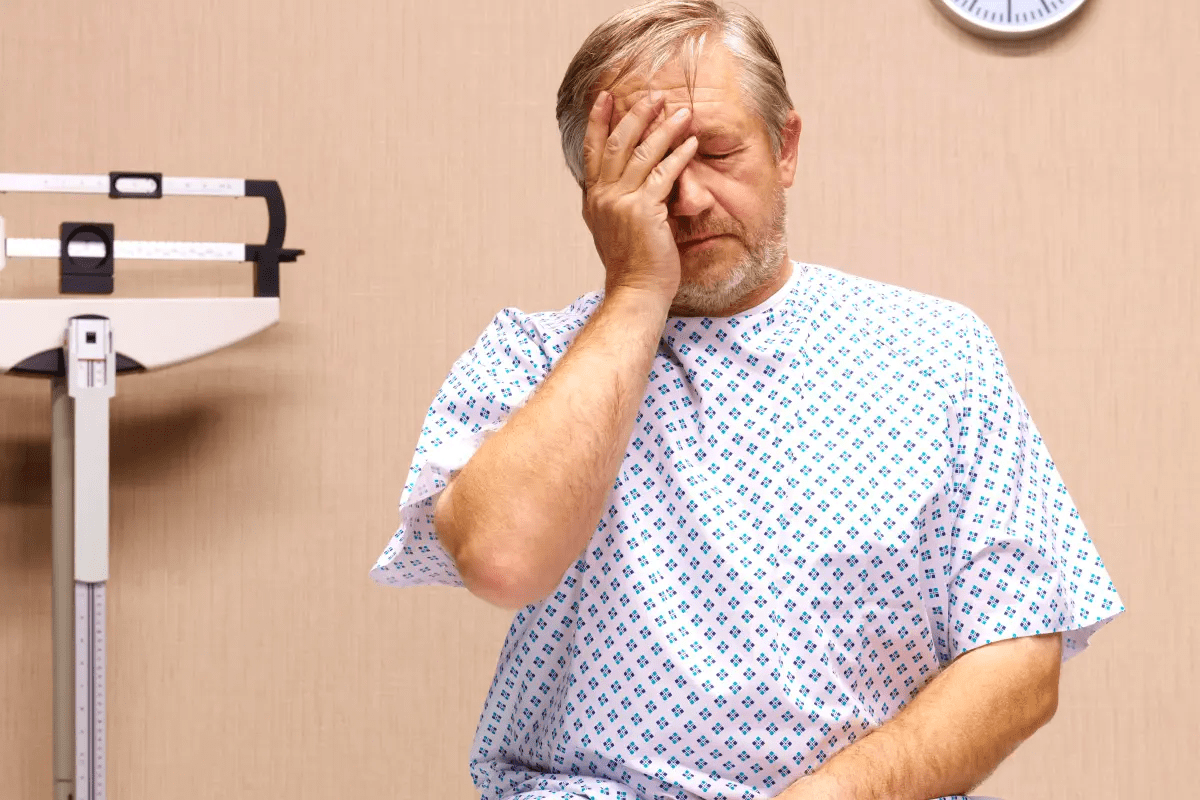What Does Colon Tumor Pain Feel Like? Colorectal cancer is a big health worry. Knowing its symptoms is key for catching it early. Abdominal cramps can be a warning sign of something serious.
It’s scary that colorectal cancer often doesn’t show symptoms early on. But when it does, you might feel sharp stomach pain or cramps. Spotting these signs early can help save lives.
Key Takeaways
- Colorectal cancer may not show symptoms in its early stages.
- Abdominal cramps can be a symptom of colon tumor pain.
- Sharp stomach pain is a possible sign of colorectal cancer.
- Early detection is key for effective treatment.
- Knowing the symptoms can lead to timely medical help.
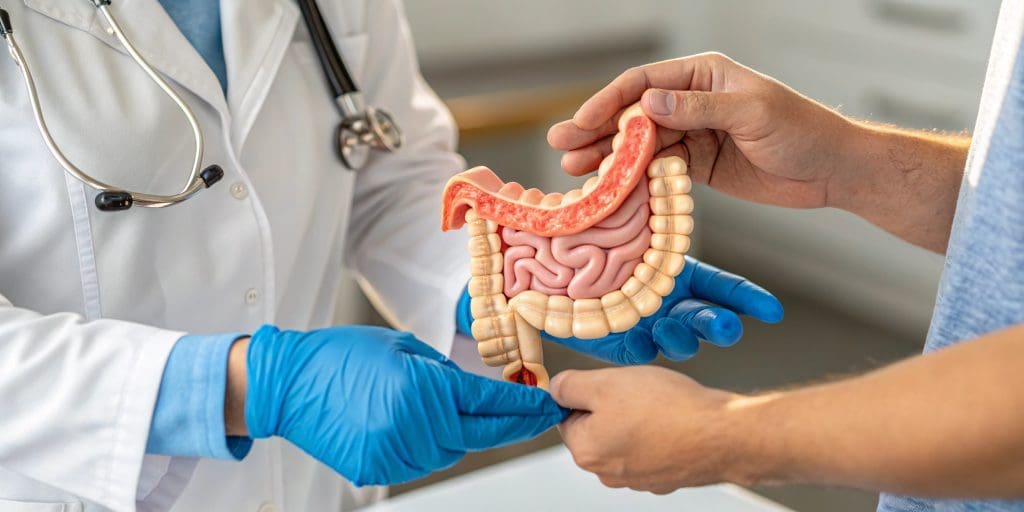
Understanding Colon Tumors and Their Symptoms
It’s important to know the symptoms of colon tumors for early treatment. These tumors, also known as colorectal tumors, can cause different symptoms. This depends on their size, location, and how they affect nearby tissues and organs.
Types of Colon Tumors
Colon tumors are divided into two types: benign and malignant. Benign tumors are not cancerous and don’t spread. Adenomatous polyps are a common benign tumor in the colon. They are not cancerous but can turn into cancer if not removed.
Malignant tumors are cancerous and can spread to other parts of the body. The most common type is adenocarcinoma, which starts in glandular cells of the colon.
Common Symptoms Beyond Pain
Colon tumors can cause more than just pain. They can change bowel habits, leading to constipation, diarrhea, or feeling like you didn’t finish going to the bathroom.
Other symptoms include unexplained weight loss and fatigue. These happen because the tumor affects nutrient absorption and the body’s response to cancer. Some people might also see rectal bleeding or blood in the stool, which means the tumor is bleeding.
Colon tumors can also cause anemia from chronic blood loss. This leads to weakness and shortness of breath. In some cases, a tumor can block the bowel, causing severe constipation, vomiting, and swelling in the abdomen.
Recognizing Colon Tumor Pain Patterns
Colon tumor pain can show up in different ways. It’s key to know its patterns. Abdominal pain or cramping can signal colorectal cancer. Knowing these signs is vital for treatment.
Intensity and Duration of Pain
The pain from colon tumors can vary a lot. Some feel mild discomfort, while others have severe pain. The pain’s length also matters; it can last from minutes to days.
Key aspects to consider regarding pain intensity and duration include:
- The level of pain, whether it’s mild, moderate, or severe
- How long the pain lasts during each episode
- Whether the pain is constant or comes and goes
Progression of Pain Over Time
Colon tumor pain can change over time. It’s important to watch these changes. They can tell us about the disease’s progress.
Noting the progression of pain involves:
- Tracking any increases or decreases in pain intensity
- Observing any changes in the location or characteristics of the pain
- Identifying any triggers that may worsen or alleviate the pain
Knowing these patterns helps people get the right medical care. It can also improve their quality of life. Always talk to healthcare experts for advice.
Abdominal Cramps and Sharp Stomach Pain
Understanding abdominal cramps and sharp stomach pain is key to spotting colon tumor symptoms. These symptoms can really affect a person’s life. They might show a serious health issue.
Distinguishing Features of Tumor-Related Cramps
Cramps from colon tumors are different. They are severe and keep coming back, sometimes getting worse. They don’t usually tie to menstrual cycles or common stomach problems.
- Persistent or recurring pain in the abdomen
- Cramps that are not relieved by typical remedies
- Pain that radiates or moves to different areas
Triggers That May Worsen Sharp Pain
Sharp stomach pain from colon tumors can get worse with certain things. Knowing what triggers it can help manage the pain.
- Eating certain foods that are hard to digest
- Physical activity or strain
- Bowel movements, if a tumor blocks the colon
It’s important to remember that these symptoms can also mean other health issues. So, getting a detailed medical check-up is vital to find out why you have abdominal cramps and sharp stomach pain.
Dull Aching Pain and Persistent Discomfort
Dull aching pain is a common symptom of colon tumors. It shows up as persistent abdominal discomfort. This pain is chronic and can signal a serious problem.
Chronic Nature of Tumor-Related Aching
The pain from colon tumors is a dull ache that lasts a long time. Unlike sharp, short pain, chronic dull aching pain stays with you. It’s caused by the tumor pressing on tissues and nerves.
A medical expert says, “The chronic pain from colon cancer is very hard. It affects both physical and mental health.”
“Pain management is key in colon cancer care. It needs a mix of treatments to help with both physical and emotional pain.”
- An Expert Oncologist
How Dull Pain Differs From Acute Pain
Dull aching pain is different from acute pain in how long it lasts and how intense it is. Acute pain is sudden and goes away once the cause is fixed. But dull aching pain keeps coming back and can change in how bad it feels. Here’s a table showing the main differences.
| Characteristics | Dull Aching Pain | Acute Pain |
| Duration | Persistent, can last for weeks or months | Temporary, usually resolves quickly |
| Intensity | Can vary, often described as mild to moderate | Usually sharp, can be severe |
| Cause | Ongoing irritation or pressure from a tumor | Often due to injury, infection, or other temporary conditions |
Knowing these differences helps patients and doctors manage pain better. It also helps spot signs of colon tumors.
Location-Specific Colon Tumor Pain
Knowing how colon tumor location affects pain is key for correct diagnosis and treatment. The pain’s location often points to the tumor’s spot in the colon. This makes it a helpful tool for doctors.
Colon tumors can happen in different parts of the colon, leading to unique pain patterns. The colon has sections like the ascending, transverse, descending, and sigmoid colon. Each part has its own pain patterns.
Lower Abdominal Pain Patterns
Lower abdominal pain is common with colon tumors, mainly in the sigmoid colon or rectum. This pain can be constant and gets worse as the tumor grows.
People often feel a dull ache or cramping in their lower abdomen. This pain can get worse with bowel movements, eating, or other colon activities.
Left Side Pain (Descending Colon)
Tumors in the descending colon cause left side pain. This pain can be sharp or crampy. It might also change bowel habits or cause other stomach issues.
Right Side Pain (Ascending Colon)
Right-sided pain can be from tumors in the ascending colon. This pain might be confused with other issues, like appendicitis.
It’s important to think of colon cancer when someone has right-sided pain, mainly in older adults or those with risk factors.
Rectal Pain and Discomfort
Rectal pain is a big symptom for tumors in the rectum. This pain can be constant or happen during bowel movements. People might also feel like they can’t fully empty their bowels or feel full in the rectum.
“Rectal pain from colon tumors can really hurt a person’s quality of life. They need quick evaluation and treatment.”
The specific pain patterns from colon tumors show how important a detailed check-up is. This includes a thorough history and physical exam to guide more tests.
Pain Associated With Bowel Movements
Understanding how bowel movements affect colon tumor pain is key for diagnosis and treatment. Colon tumors can cause a lot of discomfort during bowel movements. This pain can happen at different stages.
Pain Before, During, and After Bowel Movements
Pain with bowel movements can happen before, during, or after the act. For some, pain starts before a bowel movement. This might be because of the tumor causing intestinal obstruction or irritation.
During a bowel movement, the pain can get worse. This is true if the tumor is big or near the rectum. After a bowel movement, some people might feel better, while others might keep feeling pain. This is because the tumor irritates the tissues around it.
The kind and how bad the pain is can differ a lot between people. Some might feel sharp, stabbing pain, while others might feel a dull ache. Where the tumor is in the colon can also affect the pain felt during bowel movements.
Changes in Bowel Habits Related to Pain
Colon tumors can also cause changes in bowel habits, which might be linked to the pain. These changes can include constipation, diarrhea, or feeling like you didn’t finish going. Such changes in bowel habits can be a sign of colorectal cancer and should be checked by a doctor.
It’s important to track any changes in bowel habits and pain to talk about with healthcare providers. Keeping a record of these symptoms can help find the cause and figure out the right treatment.
Gas, Bloating, and Pressure Sensations
A colon tumor can cause symptoms like gas pain, bloating, and stomach pressure. These symptoms can make life uncomfortable and affect your quality of life.
Gas, bloating, and pressure are common but can mean something serious if linked to a colon tumor. Knowing the difference is key for early detection and treatment.
Tumor-Related Bloating vs. Common Digestive Issues
Bloating feels like your stomach is full or swollen, often with gas or discomfort. It’s common in issues like IBS or food intolerance. But, if bloating is persistent or severe, it might signal a colon tumor.
Key differences between tumor-related bloating and common digestive issues include:
- Persistence of bloating despite dietary changes or over-the-counter remedies
- Accompanying symptoms such as weight loss, blood in the stool, or changes in bowel habits
- Bloating that is localized to one area of the abdomen
| Symptom | Tumor-Related Bloating | Common Digestive Issues |
| Persistence | Often persistent despite dietary changes | May resolve with dietary adjustments |
| Accompanying Symptoms | May include weight loss, blood in stool | Typically without severe symptoms |
| Localization | Can be localized to one area | Often generalized |
Pressure and Fullness in the Abdomen
Pressure and fullness in the abdomen can be signs of a colon tumor. It feels like a heavy or tight feeling in your stomach. This feeling can be constant or come and go.
The sensation of pressure or fullness can be due to the tumor itself or due to changes in bowel habits or obstruction caused by the tumor.
It’s important to note that these symptoms can also be caused by other conditions. If you have persistent or severe gas, bloating, or pressure, see a healthcare provider. They can evaluate and diagnose the cause.
Pain After Eating and Digestive Discomfort
For those with colon tumors, eating can be a complex issue. The type of food, the meal size, and digestive health all play a role. These factors can affect how much discomfort someone feels after eating.
Food-Related Pain Triggers
Some foods can make symptoms of colorectal cancer worse. High-fiber foods, spicy or fatty meals, and foods that cause gas or bloating are common culprits. Knowing which foods cause discomfort can help manage symptoms better.
Common Food-Related Pain Triggers:
- High-fiber foods (e.g., beans, cabbage, broccoli)
- Spicy or fatty meals
- Carbonated drinks
- Dairy products (for those with lactose intolerance)
Dietary Changes That May Affect Pain Levels
Making smart diet changes can help with pain from colon tumors. Avoiding trigger foods and choosing gentle foods can make a big difference.
| Dietary Change | Potential Effect on Pain |
| Avoiding high-fiber foods | Reduces risk of bowel obstruction and discomfort |
| Eating smaller, more frequent meals | Less strain on the digestive system, potentially reducing pain |
| Increasing fluid intake | Helps prevent constipation, which can contribute to pain |
If you’re experiencing ongoing or severe pain after eating, see your doctor. They can help create a plan to manage symptoms and improve your life.
Referred Pain: Lower Back and Pelvic Discomfort
Lower back and pelvic pain might signal a serious issue like a colon tumor. This pain happens when nerves from the colon also reach other areas. This includes the lower back and pelvis, causing pain there.
How Colon Tumors Can Cause Back Pain
Colon tumors can lead to back pain in several ways. As the tumor grows, it can press on nerves that go to the back. This makes pain in the lower back that feels like other back pain issues. The tumor can also make nearby tissues inflamed and irritated, adding to the discomfort.
“The pain from colon cancer can be tricky,” – A gastroenterologist. “It might not always show up in the belly. Knowing how colon tumors and referred pain are linked is key for the right diagnosis and treatment.”
Pelvic Pain Patterns in Colon Cancer
Pelvic pain in colon cancer can differ a lot from person to person. The tumor’s location and size affect the pain’s type. For example, tumors in the rectum or sigmoid colon can cause pelvic pain. This pain can stay the same or get worse if not treated.
Some common signs of pelvic pain from colon cancer include:
- A dull, aching feeling
- Pain that gets worse with movement or bowel movements
- Sharp, stabbing pains sometimes
Spotting these patterns helps doctors diagnose and treat colon cancer better.
Differentiating Colon Tumor Pain From Other Conditions
Understanding the signs of colon tumor pain is key. This pain can feel like other stomach issues, making it hard to tell them apart.
To tell colon tumor pain apart, we need to look at the whole picture. We must also focus on the pain’s specific traits.
Similar Conditions With Overlapping Symptoms
Many conditions can seem like colon tumors. These include:
- Irritable Bowel Syndrome (IBS)
- Diverticulitis
- Inflammatory Bowel Disease (IBD)
- Gastroenteritis
These issues can cause similar pain in the belly. So, it’s important to find the differences.
Key Differences in Pain Presentation
The pain from colon tumors is different from other conditions. For example:
| Condition | Pain Characteristics |
| Colon Tumor | Often persistent, may be accompanied by changes in bowel habits or rectal bleeding |
| IBS | Typically crampy, related to bowel movements, may have periods of relief |
| Diverticulitis | Usually acute, severe, and localized to the lower left abdomen |
By knowing the unique signs of colon tumor pain, doctors can make better choices.
When to Seek Medical Attention for Unexplained Stomach Pain
If you have stomach pain that won’t go away, it’s important to know when to see a doctor. Stomach pain can mean many things, from simple digestive problems to serious issues like colon tumors.
Red Flag Symptoms That Require Immediate Care
Some symptoms with stomach pain need you to see a doctor right away. These include:
- Severe abdominal pain that is sudden and intense
- Vomiting blood or black, tarry stools
- Fever above 101.5 °F (38.6 °C)
- Abdominal tenderness or guarding (muscles tense)
- Signs of dehydration, such as excessive thirst, dark urine, or dizziness
Tracking and Describing Your Pain to Healthcare Providers
Telling your doctor about your symptoms is key to getting the right treatment. Here’s how to do it:
- Keep a pain diary to record when your pain occurs, its intensity, and any triggers.
- Note any changes in bowel habits, such as diarrhea, constipation, or blood in the stool.
- Document any other symptoms you’re experiencing, like bloating, gas, or weight loss.
- Be ready to describe your pain in detail, including its location, duration, and characteristics.
Knowing the red flag symptoms and tracking your pain helps you work with your doctor. Together, you can figure out what’s causing your stomach pain and get the right care.
Managing and Treating Colon Tumor Pain
Managing colon tumor pain needs a full plan. This includes medical treatments and care to support the patient. Pain from colon tumors can really hurt a person’s quality of life. So, it’s key to manage pain well.
Medical Pain Management Options
There are many ways to manage colon tumor pain. Pharmacological interventions like NSAIDs, opioids, and other medicines help. Also, interventional procedures like nerve blocks and chemotherapy can lessen pain.
Supportive Care and Comfort Measures
Supportive care is very important for managing colon tumor pain. Dietary changes can ease symptoms and discomfort. Also, psychological support through counseling helps patients deal with pain and stress.
“A complete pain management plan that includes both medical treatments and supportive care can greatly improve patient outcomes.”
– Healthcare Professional
Combining medical pain management with supportive care helps patients feel better. Managing colon tumor pain is complex. It involves both medical treatments and care to support the patient.
Conclusion
Understanding colon tumor pain is key to early detection and treatment. This article has covered many aspects of colon tumor pain. We looked at its patterns, intensity, and how it relates to bowel movements and eating.
Knowing the different types of pain from colon tumors is important. This includes abdominal cramps, dull aching, and sharp stomach pain. Recognizing these symptoms can help people get medical help quickly.
Managing colon tumor pain is possible with the right medical care and support. By understanding the complexities of this pain, doctors can create treatment plans tailored to each patient. This approach can lead to better health outcomes.
FAQ
What are the common symptoms of colon tumors beyond pain?
Symptoms of colon tumors include changes in bowel habits and blood in the stool. You might also feel persistent abdominal discomfort. Other signs are bloating, gas pain, and unexplained weight loss.
How does colon tumor pain typically feel?
Colon tumor pain can feel like abdominal cramps or sharp stomach pain. It might be constant or come and go. You might also feel bloated or have gas.
Can colon tumors cause pain in different locations?
Yes, colon tumors can cause pain in different spots. For example, tumors in the ascending colon might cause right side pain. Tumors in the descending colon might cause left side pain. Tumors in the rectum can cause rectal pain.
How does bowel movement affect colon tumor pain?
Bowel movements can affect colon tumor pain. You might feel pain before, during, or after. Changes in bowel habits, like constipation or diarrhea, can also happen.
Can eating certain foods trigger or worsen colon tumor pain?
Yes, eating certain foods can make colon tumor pain worse. Foods that can trigger pain include high-fiber foods, spicy foods, and foods that cause gas and bloating.
How can I differentiate colon tumor pain from other conditions?
It’s hard to tell colon tumor pain from other conditions. But, colon tumor pain is often constant and gets worse over time. Other conditions might cause pain that comes and goes.
When should I seek medical attention for unexplained stomach pain?
See a doctor for unexplained stomach pain if you have red flag symptoms. These include severe pain, vomiting blood, or black tarry stools. It’s also important to describe your pain to your doctor to help find the cause.
What are the treatment options for managing colon tumor pain?
To manage colon tumor pain, doctors might use medications or suggest dietary changes. The goal is to reduce pain and improve your quality of life.
Can colon tumors cause referred pain in the lower back and pelvis?
Yes, colon tumors can cause pain in the lower back and pelvis. This happens when the tumor irritates nearby nerves, causing pain to spread to other areas.
How can I manage pain after eating related to colon tumors?
To manage pain after eating, try to avoid foods that trigger pain. Eating smaller meals or avoiding certain foods can help reduce pain.

